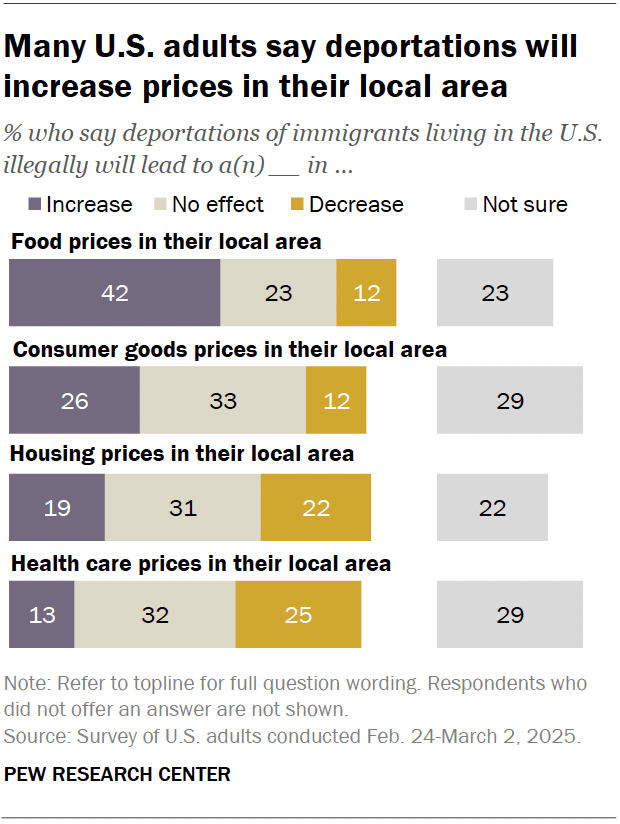Most U.S. adults favor deporting some or all immigrants who are living in the United States illegally, according to a recent Pew Research Center survey. At the same time, many expect deportations to lead to higher food prices in their area.
Around four-in-ten adults (42%) say deportations of immigrants who are in the country illegally will lead to increased food prices where they live. About a quarter (23%) expect deportations to have no effect on food prices, while 12% say they will lead to lower food prices. The survey was conducted Feb. 24-March 2, among 5,123 adults.

The public is more divided about the effect of deportations on other prices in their area:
- Consumer goods prices: 26% of adults say deportations of immigrants who are living in the U.S. illegally will lead to an increase in the cost of consumer goods such as clothing, appliances, electronics and cars. A third say they will have no effect and 12% say they will lead to lower prices.
- Housing prices: 19% expect deportations to increase the cost of housing, 31% expect no change and 22% expect costs to go down.
- Health care prices: 13% say deportations will cause health care costs to go up, 32% say there will be no effect and 25% say they will cause prices to decrease.
For all four of the costs the survey asked about, at least a fifth of U.S. adults say they are not sure what effect deportations will have.
Views by party

Democrats and Democratic-leaning independents are much more likely than Republicans and Republican leaners to say deportations of immigrants who are in the U.S. illegally will lead to higher prices.
In the case of food prices, a majority of Democrats (64%) expect costs to go up as a result of deportations. Around one-in-five Republicans (19%) share this view.
Democrats are also much more likely than Republicans to expect deportations to lead to higher prices for consumer goods, housing and health care. For each of these types of goods and services, no more than about one-in-ten Republicans expect prices to rise because of deportations.
Many Republicans expect deportations to result in lower prices for certain goods and services. For example, 43% of Republicans say deportations will cause health care prices to decrease, and 35% say the same about housing prices.
Views by demographic group
Views on these questions also differ by demographic factors such as race, ethnicity, nativity and education.
For instance, 55% of Hispanic adults say deportations will lead to higher food prices, compared with 48% of Asian adults, 42% of Black adults and 37% of White adults. Immigrants are far more likely than U.S.-born adults to say they expect deportations to raise food prices (56% vs. 39%). And U.S. adults with higher levels of educational attainment are also more likely than people with less education to hold this view.
Note: Here are the questions used for this analysis, the topline and the survey methodology.

